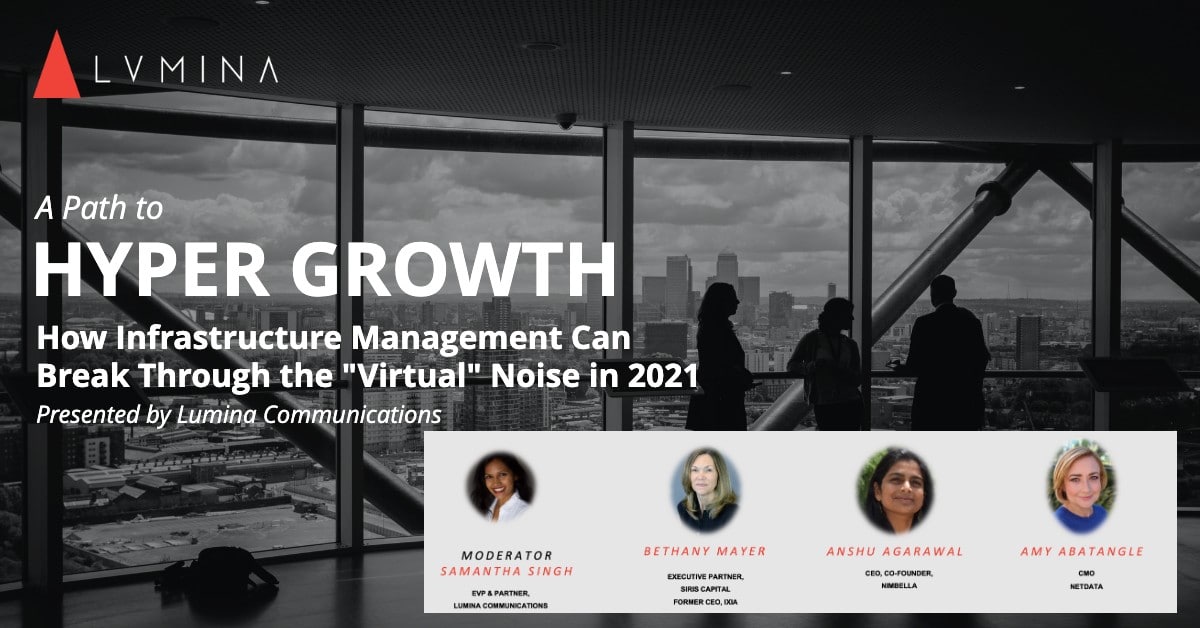NEWS
Webinar Recap: How Infrastructure Management Companies Can Break Through the Noise GET IN TOUCH
Webinar Recap: How Infrastructure Management Companies Can Break Through the Noise
In a world turned upside down by the Coronavirus pandemic, digital solutions of every sort proliferated during the past year. But in an increasingly crowded field, what’s the real value that these emerging infrastructure technologies can bring to an enterprise and the developer community? And if you’re a player in the IT infrastructure industry, what’s the most effective way to reach the people responsible for influencing or making purchase decisions?
Those were the questions posed to a panel of three distinguished technology leaders in a March 8 webinar organized by Lumina Communications and moderated by Lumina Executive VP and Partner Samantha Singh. In honor of International Women’s Day, which fell on the same date, the invited panelists included Amy Abatangle, CMO at Netdata – a provider of real-time infrastructure monitoring solutions; Anshu Agarawal, CEO and Co-Founder of Nimbella – maker of an enterprise-grade stateful serverless platform; and Bethany Mayer, Executive Partner, Siris Capital Group, a private equity firm that invests in mission-critical technology companies.
Along with the near-collapse of the hospitality, travel, and dining industries, perhaps the most dramatic business shift triggered by the pandemic was when companies directed their previously office-based personnel to work from home using technology that was never designed to meet the distinctive needs of a distributed workforce. Reliance on cloud hosting, which was already well underway before the Coronavirus, accelerated tremendously in 2020, along with the need for multi-cloud architecture and all the future-proofing technologies that go along with it. Artificial intelligence, advanced analytics, 5G, edge computing were just a few of the many technical innovations stepping up last year.
Yet even though most of these technologies are remarkably advanced, and their users make up a highly sophisticated audience, the decision to invest money and time in new digital solutions remain a stubbornly human endeavor. As a result, the ways of reaching those individuals and making the case for product procurement, tend to be very people-centric. Among the panelists’ suggestions:
Be a good listener. Foster collaboration and interaction rather than using top-down messages.
- Some users can’t be persuaded; let them test the product for free to convince themselves.
- Don’t rely on website ads; most developers have disabled theirs and would never click on them.
- Game-ify; turn your messaging into competitive games that users can play online.
- Cultivate respectful interactions and authentic conversations with developers.
- Engage with users early in the development process; secure and use their feedback ASAP.
- Create user communities to drive conversations; figure out ways they can interact.
- Assure authenticity by providing information focused on each customer’s problems.
- Every business is made up of consumers. Many principles of B2C marketing also apply in the B2B world.
- Communicate using a flexible platform with individualized messaging; one size does NOT fit all.
- Dial back the noise; people are distracted, overdosing on messages, and having trouble sorting out what’s valuable. Nonstop emailing can be counterproductive.
- Double-down in your focus on the ideal customer profile.
- Don’t become paralyzed by seeking perfection; everyone makes and learns from mistakes.
- Recognize the value that PR can bring to becoming more visible, gaining more recognition, becoming an industry thought leader.
- In today’s digital environment, the real value of PR has become more measurable than ever.
